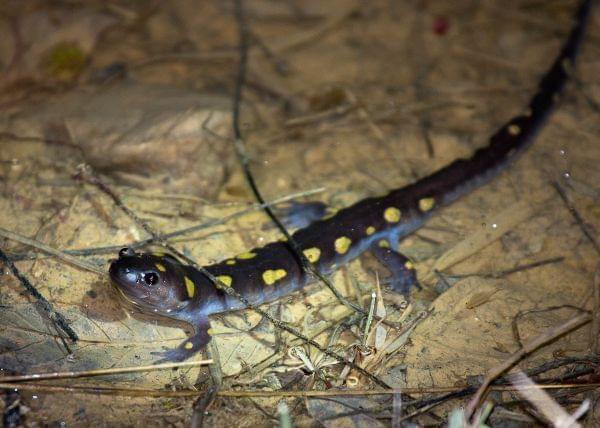Appreciating Illinois amphibians and the habitats that support them

A spotted salamander. Rob Kanter
It may be too early in the year to contemplate April showers bringing May flowers. But in much of Illinois heavy rains in late February and early March trigger an astonishing and ancient natural phenomenon—the annual congregation of amphibians in the waters where they breed.
The participants in the initial phase of this aquatic love fest, which begins in water cold enough to stun people, include frogs that are known by their vocalizations—spring peepers [pictured], whose once-per-second ascending peeps can be heard day and night, and western chorus frogs, whose call is often compared to the sound produced by running a stick over the teeth of a comb.
__medium.jpg'}) When I tell people I’m going out to find these frogs before winter is even over, they often respond with concern. “What happens if the weather turns again,” they ask, “won’t the frogs freeze?” The amazing answer to that question is yes—but freezing doesn’t kill them. A combination of physiological adaptations allows them to restart after periods spent as “frogcicles,” when most of the water in their bodies has turned to ice and their organs have all ceased functioning.
When I tell people I’m going out to find these frogs before winter is even over, they often respond with concern. “What happens if the weather turns again,” they ask, “won’t the frogs freeze?” The amazing answer to that question is yes—but freezing doesn’t kill them. A combination of physiological adaptations allows them to restart after periods spent as “frogcicles,” when most of the water in their bodies has turned to ice and their organs have all ceased functioning.
These vocal frogs are joined in the frigid water by other more secretive amphibians. To me, the most fascinating of these are the eight species of salamanders that are known collectively as mole salamanders.
In central Illinois the most common member of this family is the six-inch-long smallmouth salamander [pictured], a blackish creature with blue and grey markings that give it a marbled appearance. The eastern tiger salamander can be found here, too, although I have to admit I’ve never seen one. A tiger salamander may grow to more that a foot in length, and it is marked by yellow spots that cover more and more of its body as it ages. You may or may not remember it, but the tiger salamander was elected the official state amphibian of Illinois in a 2004 contest sponsored by then Lieutenant Governor, Pat Quinn.
As their group name suggests, mole salamanders spend most of the year underground. There they move about in natural gaps, and the tunnels and burrows created by small mammals. They feed on a variety of invertebrates, including earthworms, slugs, and insects.
In the spring, though, as the earth thaws and the ice recedes, rainy nights bring mole salamanders above ground, and they trundle overland seeking the ephemeral pools where they were born. Ephemeral pools are wetlands that hold water far enough into the summer for amphibian larvae to mature, but which dry up at some point in most years. This characteristic prevents fish from becoming established there, and that’s important because fish eat amphibian eggs and young. [Pictured is an ephemeral pool at the Urbana Park District's Busey Woods.]
If you were to shine a light into such a pool on a spring night you would be amazed at how many salamanders you can see, and surprised at how gracefully they swim. You might also be interested to see how many other forms of life are active in such cold water—delicate, inch-long fairy shrimp, ferocious diving beetles, and more.
Looking into an ephemeral pool during the day you might see amphibian eggs, held together in a mass with a jelly-like substance, and attached to twigs or other underwater structure.
While it is still possible to find ephemeral pools where you can witness the springtime congregation of amphibians in Illinois, it’s not easy. More than 90 percent of the wetland acres that once existed in the state have been lost to agriculture and urbanization, and only a tiny fraction (0.05%) of the state’s historic wetlands persist in relatively undisturbed condition.
Whether future generations have the opportunity to experience the springtime awakening of life in ephemeral pools depends on whether our generation acts to preserve and restore them.

